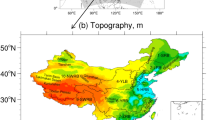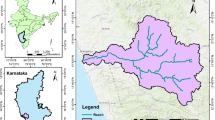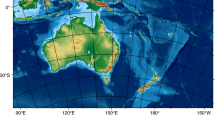Abstract
Due to the considerable biases in general circulation models (GCMs) simulation, bias correction methods are required and widely applied to reduce the model biases for impact studies. This study evaluated the performance of two bias correction methods, quantile delta mapping (QDM) and scaled distribution mapping (SDM), for generating high-resolution daily maximum temperature (Tmax) and minimum temperature (Tmin) projections for Canada using the latest GCMs from the Coupled Model Intercomparison Project phase 6 (CMIP6). CMIP6 GCMs show overall consistency with observations before and after bias correction, with better performance on Tmax compared to Tmin. QDM shows better performance relative to observations while SDM shows superior skill in preserving the raw climate signals. QDM and SDM methods are effective in reducing the biases of Tmax and Tmin for all GCMs. Both methods show similar skills in reproducing monthly probability distribution and capturing seasonal spatial patterns over Canada. Multi-model ensemble means have good performance in simulating the monthly mean of Tmax and Tmin but poor performance for high and low quantiles as well as standard deviation. QDM and SDM corrected ensemble means have the best performance. This study presents a comprehensive assessment of bias correction methods applications for individual CMIP6 GCMs and their multi-model ensemble means for high-resolution daily temperature predictions for Canada, providing a reference significance for bias correction studies as well as technical support for further impact assessment and adaptation planning around the world.









Similar content being viewed by others
Data availability
All data sets used in this paper are publicly available through the references cited and can be accessed through the web portals https://www.pacificclimate.org/data/daily-gridded-meteorological-datasets (NRCANmet observation data) and https://esgf-node.llnl.gov/projects/cmip6/ (CMIP6 data).
References
Blöschl G, Hall J, Parajka J, Perdigão RAP, Merz B, Arheimer B, Aronica GT, Bilibashi A, Bonacci O, Borga M, Čanjevac I, Castellarin A, Chirico GB, Claps P, Fiala K, Frolova N, Gorbachova L, Gül A, Hannaford J, Harrigan S, Kireeva M, Kiss A, Kjeldsen TR, Kohnová S, Koskela JJ, Ledvinka O, Macdonald N, Mavrova-Guirguinova M, Mediero L, Merz R, Molnar P, Montanari A, Murphy C, Osuch M, Ovcharuk V, Radevski I, Rogger M, Salinas JL, Sauquet E, Šraj M, Szolgay J, Viglione A, Volpi E, Wilson D, Zaimi K, Živković N (2017) Changing climate shifts timing of European floods. Science 357(6351):588–590
Bürger G, Sobie SR, Cannon AJ, Werner AT, Murdock TQ (2013) Downscaling extremes: an intercomparison of multiple methods for future climate. J Clim 26(10):3429–3449
Burkart KG, Brauer M, Aravkin AY, Godwin WW, Hay SI, He J, Iannucci VC, Larson SL, Lim SS, Liu J, Murray CJL, Zheng P, Zhou M, Stanaway JD (2021) Estimating the cause-specific relative risks of non-optimal temperature on daily mortality: a two-part modelling approach applied to the Global Burden of Disease Study. Lancet 398(10301):685–697
Cannon AJ (2017) Multivariate quantile mapping bias correction: an N-dimensional probability density function transform for climate model simulations of multiple variables. Clim Dyn 50(1–2):31–49
Cannon AJ, Sobie SR, Murdock TQ (2015) Bias correction of GCM precipitation by quantile mapping: how well do methods preserve changes in quantiles and extremes? J Clim 28(17):6938–6959
Casanueva A, Herrera S, Iturbide M, Lange S, Jury M, Dosio A, Maraun D, Gutiérrez JM (2020) Testing bias adjustment methods for regional climate change applications under observational uncertainty and resolution mismatch. Atmos Sci Lett. https://doi.org/10.1002/asl.978
Chen J, Brissette FP, Leconte R (2011a) Uncertainty of downscaling method in quantifying the impact of climate change on hydrology. J Hydrol 401(3–4):190–202
Chen J, Brissette FP, Poulin A, Leconte R (2011b) Overall uncertainty study of the hydrological impacts of climate change for a Canadian watershed. Water Resour Res. https://doi.org/10.1029/2011WR010602
Chen J, Brissette FP, Zhang XJ, Chen H, Guo S, Zhao Y (2019) Bias correcting climate model multi-member ensembles to assess climate change impacts on hydrology. Clim Change 153(3):361–377
Cheng GH, Huang GH, Dong C, Zhu JX, Zhou X, Yao Y (2017) An evaluation ofCMIP5 GCM simulations over the Athabasca River Basin, Canada. River Res Appl 33(5):823–843
Cort JW, Kenji M (2005) Advantages of the mean absolute error (MAE) over the root mean square error (RMSE) in assessing average model performance. Climate Res 30(1):79–82
Demirhan H (2022) Solar photovoltaic utilization in electricity generation to tackle climate change. J Environ Inform 40(1):41–55
Eum H-I, Cannon AJ (2017) Intercomparison of projected changes in climate extremes for South Korea: application of trend preserving statistical downscaling methods to the CMIP5 ensemble. Int J Climatol 37(8):3381–3397
Eyring V, Bony S, Meehl GA, Senior CA, Stevens B, Stouffer RJ, Taylor KE (2016) Overview of the coupled model intercomparison project phase 6 (CMIP6) experimental design and organization. Geosci Model Dev 9(5):1937–1958
Fang GH, Yang J, Chen YN, Zammit C (2015) Comparing bias correction methods in downscaling meteorological variables for a hydrologic impact study in an arid area in China. Hydrol Earth Syst Sci 19(6):2547–2559
Forster PM, Maycock AC, McKenna CM, Smith CJ (2020) Latest climate models confirm need for urgent mitigation. Nat Clim Chang 10(1):7–10
Gettelman A, Hannay C, Bacmeister JT, Neale RB, Pendergrass AG, Danabasoglu G, Lamarque JF, Fasullo JT, Bailey DA, Lawrence DM, Mills MJ (2019) High climate sensitivity in the community earth system model version 2 (CESM2). Geophys Res Lett 46(14):8329–8337
Grose MR, Narsey S, Delage FP, Dowdy AJ, Bador M, Boschat G, Chung C, Kajtar JB, Rauniyar S, Freund MB, Lyu K, Rashid H, Zhang X, Wales S, Trenham C, Holbrook NJ, Cowan T, Alexander L, Arblaster JM, Power S (2020) Insights from CMIP6 for Australia’s future climate. Earth’s Future. https://doi.org/10.1029/2019EF001469
Hamed MM, Nashwan MS, Shahid S (2021) Inter-comparison of historical simulation and future projections of rainfall and temperature by CMIP5 and CMIP6 GCMs over Egypt. Int J Climatol 42(8):4316–4332
Hempel S, Frieler K, Warszawski L, Schewe J, Piontek F (2013) A trend-preserving bias correction—the ISI-MIP approach. Earth Syst Dyn 4(2):219–236
Hopkinson RF, McKenney DW, Milewska EJ, Hutchinson MF, Papadopol P, Vincent LA (2011) Impact of aligning climatological day on gridding daily maximum-minimum temperature and precipitation over Canada. J Appl Meteorol Climatol 50(8):1654–1665
Huang WW, Chen XJ, Fan YR, Li YP (2022) Management of drinking water source in rural communities under climate change. J Environ Inform 39(2):136–151
IPCC (2021) Climate Change 2021: The Physical Science Basis. Contribution of Working Group I to the Sixth Assessment Report of the Intergovernmental Panel on Climate Change [Masson-Delmotte V, Zhai P, Pirani A, Connors SL, Péan C, Berger S, Caud N, Chen Y, Goldfarb L, Gomis MI, Huang M, Leitzell K, Lonnoy E, Matthews JBR, Maycock TK, Waterfield T, Yelekçi O, Yu R, Zhou B (eds)]. Cambridge University Press, Cambridge, United Kingdom and New York, NY, USA, 2391 pp. https://doi.org/10.1017/9781009157896
Islam SU, Déry SJ (2017) Evaluating uncertainties in modelling the snow hydrology of the Fraser River Basin, British Columbia, Canada. Hydrol Earth Syst Sci 21(3):1827–1847
Jeong DI, Sushama L, Diro GT, Khaliq MN, Beltrami H, Caya D (2015) Projected changes to high temperature events for Canada based on a regional climate model ensemble. Clim Dyn 46(9–10):3163–3180
Lanzante JR, Adams-Smith D, Dixon KW, Nath M, Whitlock CE (2019) Evaluation of some distributional downscaling methods as applied to daily maximum temperature with emphasis on extremes. Int J Climatol 40(3):1571–1585
Li X, Li Z (2022) Global water availability and its distribution under the coupled model intercomparison project phase six scenarios. Int J Climatol. https://doi.org/10.1002/joc.7559
Li H, Sheffield J, Wood EF (2010) Bias correction of monthly precipitation and temperature fields from intergovernmental panel on climate change AR4 models using equidistant quantile matching. J Geophys Res. https://doi.org/10.1029/2009JD012882
Li X, Li Z, Huang W, Zhou P (2020) Performance of statistical and machine learning ensembles for daily temperature downscaling. Theoret Appl Climatol 140(1–2):571–588
Liu YL, Du JZ, Wang Q, Yang W, Cui BS (2022) Toward an assessment of runoff and thermal connectivity in a river-lake system within an urban environment. J Environ Inform 40(2):125–140
Mandal S, Srivastav RK, Simonovic SP (2016) Use of beta regression for statistical downscaling of precipitation in the Campbell River basin, British Columbia, Canada. J Hydrol 538:49–62
Maraun D (2013) Bias correction, quantile mapping, and downscaling: revisiting the inflation issue. J Clim 26(6):2137–2143
Maraun D (2016) Bias correcting climate change simulations—a critical review. Curr Clim Change Rep 2(4):211–220
Masud B, Cui Q, Ammar ME, Bonsal BR, Islam Z, Faramarzi M (2021) Means and extremes: evaluation of a cmip6 multi-model ensemble in reproducing historical climate characteristics across Alberta, Canada. Water. https://doi.org/10.3390/w13050737
Matthews TK, Wilby RL, Murphy C (2017) Communicating the deadly consequences of global warming for human heat stress. Proc Natl Acad Sci USA 114(15):3861–3866
Maurer EP, Hidalgo HG, Das T, Dettinger MD, Cayan DR (2010) The utility of daily large-scale climate data in the assessment of climate change impacts on daily streamflow in California. Hydrol Earth Syst Sci 14(6):1125–1138
McKenney DW, Hutchinson MF, Papadopol P, Lawrence K, Pedlar J, Campbell K, Milewska E, Hopkinson RF, Price D, Owen T (2011) Customized spatial climate models for North America. Bull Am Meteorol Soc 92(12):1611–1622
Nie S, Fu S, Cao W, Jia X (2020) Comparison of monthly air and land surface temperature extremes simulated using CMIP5 and CMIP6 versions of the Beijing Climate Center climate model. Theoret Appl Climatol 140(1–2):487–502
Pierce DW, Cayan DR, Thrasher BL (2014) Statistical downscaling using localized constructed analogs (LOCA)*. J Hydrometeorol 15(6):2558–2585
Pierce DW, Cayan DR, Maurer EP, Abatzoglou JT, Hegewisch KC (2015) Improved bias correction techniques for hydrological simulations of climate change*. J Hydrometeorol 16(6):2421–2442
Qin X, Dai C (2022) Comparison of different quantile delta mapping schemes in frequency analysis of precipitation extremes over mainland Southeast Asia under climate change. J Hydrol. https://doi.org/10.1016/j.jhydrol.2021.127421
Sheridan SC, Allen MJ (2015) Changes in the frequency and intensity of extreme temperature events and human health concerns. Curr Clim Change Rep 1(3):155–162
Singh H, Reza Najafi M (2020) Evaluation of gridded climate datasets over Canada using univariate and bivariate approaches: Implications for hydrological modelling. J Hydrol. https://doi.org/10.1016/j.jhydrol.2020.124673
Singh H, Najafi MR, Cannon AJ (2021) Characterizing non-stationary compound extreme events in a changing climate based on large-ensemble climate simulations. Clim Dyn 56(5–6):1389–1405
Singh H, Najafi MR, Cannon A (2022) Evaluation and joint projection of temperature and precipitation extremes across Canada based on hierarchical Bayesian modelling and large ensembles of regional climate simulations. Weather Clim Extremes. https://doi.org/10.1016/j.wace.2022.100443
Smith SJ, Edmonds J, Hartin CA, Mundra A, Calvin K (2015) Near-term acceleration in the rate of temperature change. Nat Clim Chang 5(4):333–336
Sun Q, Miao C, AghaKouchak A, Mallakpour I, Ji D, Duan Q (2020) Possible increased frequency of ENSO-related dry and wet conditions over some major watersheds in a warming climate. Bull Am Meteor Soc 101(4):E409–E426
Switanek MB, Troch PA, Castro CL, Leuprecht A, Chang H-I, Mukherjee R, Demaria EMC (2017) Scaled distribution mapping: a bias correction method that preserves raw climate model projected changes. Hydrol Earth Syst Sci 21(6):2649–2666
Taylor KE (2001) Summarizing multiple aspects of model performance in a single diagram. J Geophys Res Atmos 106(D7):7183–7192
Teutschbein C, Seibert J (2012) Bias correction of regional climate model simulations for hydrological climate-change impact studies: review and evaluation of different methods. J Hydrol 456–457:12–29
Thrasher B, Maurer EP, McKellar C, Duffy PB (2012) Technical note: bias correcting climate model simulated daily temperature extremes with quantile mapping. Hydrol Earth Syst Sci 16(9):3309–3314
Tong Y, Gao X, Han Z, Xu Y, Xu Y, Giorgi F (2020) Bias correction of temperature and precipitation over China for RCM simulations using the QM and QDM methods. Clim Dyn. https://doi.org/10.1007/s00382-020-05447-4
Wang L, Chen W (2014) A CMIP5 multimodel projection of future temperature, precipitation, and climatological drought in China. Int J Climatol 34(6):2059–2078
Wang F, Tian D (2022) On deep learning-based bias correction and downscaling of multiple climate models simulations. Clim Dyn. https://doi.org/10.1007/s00382-022-06277-2
Werner AT, Cannon AJ (2016) Hydrologic extremes—an intercomparison of multiple gridded statistical downscaling methods. Hydrol Earth Syst Sci 20(4):1483–1508
Wood AW, Leung LR, Sridhar V, Lettenmaier DP (2004) Hydrologic implications of dynamical and statistical approaches to downscaling climate model outputs. Clim Change 62:189–216
Wu Y, Miao C, Duan Q, Shen C, Fan X (2020) Evaluation and projection of daily maximum and minimum temperatures over China using the high-resolution NEX-GDDP dataset. Clim Dyn 55(9–10):2615–2629
Xie S-P, Deser C, Vecchi GA, Collins M, Delworth TL, Hall A, Hawkins E, Johnson NC, Cassou C, Giannini A, Watanabe M (2015) Towards predictive understanding of regional climate change. Nat Clim Chang 5(10):921–930
Yang X, Wood EF, Sheffield J, Ren L, Zhang M, Wang Y (2018) Bias correction of historical and future simulations of precipitation and temperature for China from CMIP5 models. J Hydrometeorol 19(3):609–623
Yuan X, Wang L, Wu P, Ji P, Sheffield J, Zhang M (2019) Anthropogenic shift towards higher risk of flash drought over China. Nat Commun 10(1):4661
Zelinka MD, Myers TA, McCoy DT, Po‐Chedley S, Caldwell PM, Ceppi P, Klein SA, Taylor KE (2020) Causes of higher climate sensitivity in CMIP6 models. Geophys Res Lett 47(1):e2019GL085782
Zhang Y, Li Q, Ge Y, Du X, Wang H (2022) Growing prevalence of heat over cold extremes with overall milder extremes and multiple successive events. Commun Earth Environ. https://doi.org/10.1038/s43247-022-00404-x
Zhu L, Kang W, Li W, Luo J-J, Zhu Y (2022) The optimal bias correction for daily extreme precipitation indices over the Yangtze-Huaihe River Basin, insight from BCC-CSM1.1-m. Atmos Res. https://doi.org/10.1016/j.atmosres.2022.106101
Acknowledgements
This study was supported by the Natural Sciences and Engineering Research Council of Canada (NSERC) and the McMaster Engineering Big Ideas Initiative of McMaster University. We thank Nature Resources Canada for providing observed temperature data. We acknowledge the World Climate Research Programme, which, through its Working Group on Coupled Modelling, coordinated and promoted CMIP6. We thank the climate modeling groups for producing and making available their model output, the Earth System Grid Federation (ESGF) for archiving the data and providing access (https://esgf-node.llnl.gov/projects/cmip6/), and the multiple funding agencies who support CMIP6 and ESGF.
Funding
This study was supported by the Natural Sciences and Engineering Research Council of Canada (NSERC) and the McMaster Engineering Big Ideas Initiative of McMaster University.
Author information
Authors and Affiliations
Contributions
XL: Investigation; methodology; writing—original draft. ZL: Supervision; writing—review and editing.
Corresponding author
Ethics declarations
Conflict of interest
The authors have no conflicts of interest to declare that are relevant to the content of this article.
Ethical approval and consent to participate
Not applicable.
Consent for publication
Not applicable.
Additional information
Publisher's Note
Springer Nature remains neutral with regard to jurisdictional claims in published maps and institutional affiliations.
Rights and permissions
Springer Nature or its licensor (e.g. a society or other partner) holds exclusive rights to this article under a publishing agreement with the author(s) or other rightsholder(s); author self-archiving of the accepted manuscript version of this article is solely governed by the terms of such publishing agreement and applicable law.
About this article
Cite this article
Li, X., Li, Z. Evaluation of bias correction techniques for generating high-resolution daily temperature projections from CMIP6 models. Clim Dyn 61, 3893–3910 (2023). https://doi.org/10.1007/s00382-023-06778-8
Received:
Accepted:
Published:
Issue Date:
DOI: https://doi.org/10.1007/s00382-023-06778-8




